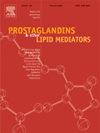Protection of lutein against the toxic effect of cisplatin on liver in male rat
IF 2.5
3区 生物学
Q3 BIOCHEMISTRY & MOLECULAR BIOLOGY
Prostaglandins & other lipid mediators
Pub Date : 2025-04-24
DOI:10.1016/j.prostaglandins.2025.106995
引用次数: 0
Abstract
Objective
A major challenge in cancer treatment is the detrimental effects of anticancer drugs on healthy organs and tissues. This study aims to investigate the protective effects of Lutein (LU) against Cisplatin (CT)-induced toxicity in rat liver, utilizing biochemical and histopathological assessments.
Methods
In this study, CT was administered intraperitoneally (i.p.) at a dose of 10 mg/kg, while LU was administered orally at a dose of 100 mg/kg. The experiment was conducted over a 7-day period with 28 male Sprague-Dawley rats (weighing 210–265 g, aged 11 weeks), divided into four groups (n = 7): Control, LU, CT, and CT + LU.
Results
CT-induced liver injury was identified as a dose-limiting side effect of CT. Compared to the CT group, the CT + LU group exhibited a significant decrease in malondialdehyde (MDA) levels and an increase in superoxide dismutase (SOD), catalase (CAT), and glutathione (GSH) levels. In the CT group, a significant increase in the levels of gamma-glutamyl transferase (GGT), alanine aminotransferase (ALT), aspartate aminotransferase (AST), and lactate dehydrogenase (LDH) was observed, compared to the control group (p < 0.05). When comparing the CT + LU group with the CT group, a significant reduction in the levels of GGT, ALT, AST, and LDH was observed (p < 0.05). Histopathological analysis revealed liver damage in the CT group, characterized by leukocyte infiltration, sinusoidal dilatation, Councilman body formation, and hepatocellular degeneration and steatosis. In contrast, the CT + LU group exhibited only mild sinusoidal dilatation, with no other significant lesions. Immunohistochemical analysis showed positive staining for tumour necrosis factor-alpha (TNF-α) and caspase-3 in the liver tissue of CT group rats, which was significantly reduced in the CT + LU group. The staining pattern in the CT + LU group was similar to that of the control and LU groups.
Conclusion
The results of this study suggest that LU mitigates oxidative stress, enhances antioxidant defences, and supports liver function. Furthermore, LU demonstrates a protective effect against CT-induced liver damage, indicating its potential as a pharmacological agent for preventing CT-induced hepatic injury.
叶黄素对雄性大鼠顺铂肝毒性的保护作用
目的抗癌药物对健康器官和组织的不良影响是癌症治疗的一个主要挑战。本研究旨在探讨叶黄素(Lutein, LU)对顺铂(Cisplatin, CT)诱导的大鼠肝脏毒性的保护作用。方法CT腹腔注射剂量为10 mg/kg, LU口服剂量为100 mg/kg。实验以体重210 ~ 265 g, 11周龄的雄性Sprague-Dawley大鼠28只,分为4组(n = 7):对照组、LU组、CT组和CT + LU组。结果CT诱导的肝损伤被确定为CT的剂量限制性副作用。与CT组相比,CT + LU组丙二醛(MDA)水平显著降低,超氧化物歧化酶(SOD)、过氧化氢酶(CAT)和谷胱甘肽(GSH)水平显著升高。CT组与对照组相比,γ -谷氨酰转移酶(GGT)、丙氨酸转氨酶(ALT)、天冬氨酸转氨酶(AST)和乳酸脱氢酶(LDH)水平显著升高(p <; 0.05)。CT + LU组与CT组比较,GGT、ALT、AST、LDH水平均显著降低(p <; 0.05)。组织病理分析显示CT组肝损伤,表现为白细胞浸润、窦状窦扩张、曼氏体形成、肝细胞变性和脂肪变性。相比之下,CT + LU组仅表现为轻度正弦窦扩张,未见其他明显病变。免疫组化分析显示,CT组大鼠肝组织肿瘤坏死因子-α (TNF-α)、caspase-3阳性染色,CT + LU组明显降低。CT + LU组的染色模式与对照组和LU组相似。结论LU可减轻氧化应激,增强抗氧化防御能力,支持肝功能。此外,LU对ct诱导的肝损伤具有保护作用,表明其有可能成为预防ct诱导的肝损伤的药理药物。
本文章由计算机程序翻译,如有差异,请以英文原文为准。
求助全文
约1分钟内获得全文
求助全文
来源期刊

Prostaglandins & other lipid mediators
生物-生化与分子生物学
CiteScore
5.80
自引率
3.40%
发文量
49
审稿时长
2 months
期刊介绍:
Prostaglandins & Other Lipid Mediators is the original and foremost journal dealing with prostaglandins and related lipid mediator substances. It includes basic and clinical studies related to the pharmacology, physiology, pathology and biochemistry of lipid mediators.
Prostaglandins & Other Lipid Mediators invites reports of original research, mini-reviews, reviews, and methods articles in the basic and clinical aspects of all areas of lipid mediator research: cell biology, developmental biology, genetics, molecular biology, chemistry, biochemistry, physiology, pharmacology, endocrinology, biology, the medical sciences, and epidemiology.
Prostaglandins & Other Lipid Mediators also accepts proposals for special issue topics. The Editors will make every effort to advise authors of the decision on the submitted manuscript within 3-4 weeks of receipt.
 求助内容:
求助内容: 应助结果提醒方式:
应助结果提醒方式:


